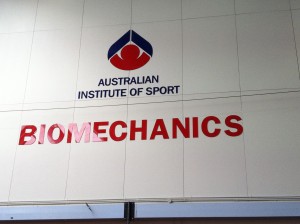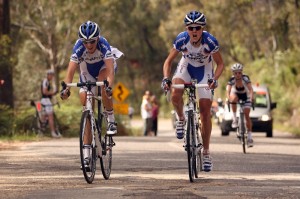Note: With apologies to regular Ride Happy readers, the following post is entirely factual. The AIS selection camp was so hard it needs no embellishment or exaggeration. I welcome anyone who thinks that women's racing is soft to complete even half of what we did for the last 10 days.
Last night I returned from the AIS selection camp. The aim of the camp was to select AIS scholarship holders for 2012. Fifteen of the best girls from around the country were nominated by their state institute to attend. By the end of the camp, only 5 girls remained. I was one of them.

In a significant shift from past selection policy, CA introduced a 'survival' theme to the camp. The coaches and physiologists worked closely with the SAS and the Commandos to design a camp that would push each of us to our physical, mental and emotional limits. Very deliberately, we were exhausted physically within the first 3 days. We were given no feedback, either positive or negative. We had no spare time to ourselves. We were never told more than a few hours in advance what challenge we would face next. We were sleep-deprived, woken unexpectedly, and at times not fed. Our challenges took us far outside our comfort zones. Our performances - good or bad - were greeted by blank expressions. Each night, we had intense de-briefs where a few of us would be grilled mercilessly about the decisions we had made that day. We were videoed and interviewed, all the time - constantly under the microscope. Half the time they probably didn't even have tapes in the cameras.

There were 2 culls during the camp - the first after 4 days, and the second after 7. Before each cull, we would all have to pack our bikes and bags as if we were going home. Then we had to nominate, by secret ballot, 4 girls whom we thought should be sent home. (This happened after the selectors had made their decision.) Then, one by one, we were called into a private meeting room in another part of the AIS and told whether we would be continuing the camp or not. The girls who didn't make it just disappeared. No goodbyes. The girls who passed were sent to another room where they discovered who else had made it and when the next challenge started. Those who made it past the first cull were rewarded by having their phones and laptops - all means of communication with the outside world - confiscated.

The challenges were varied and intense. On the first day we had to re-cable our bikes, perform repeated sprint efforts, do a lab step-test (VO2 max to exhaustion) and complete a skills session where we tried to knock each other off our bikes. On the second day we had a race up Black Mountain, a race down it, a power sprint lab test (sprint efforts of 6 secs, 15 secs, 30 secs, 1 min, 4 min and 10 mins) and more skills drills with pushing each other, jumping over obstacles and picking bidons off the ground while riding. On the third day we had an individual pursuit challenge, another lab test (30 min TT) and more advanced skills work. Add to this early morning blood tests, DXA scans, 3D body scans and skin folds, plus end-of-day debrief meetings... Plus washing and preparing 180 bidons, media training, washing the team vans... We were too busy to feel exhausted. By the end of the third day we were down 1 broken collarbone and around $1,500 worth of broken rims.

The idea of the challenges was to replicate (and usually amplify) the challenges that riders face racing overseas in the pro peleton. Sometimes, overseas, you face language barriers. We had drivers who spoke nothing but French, and dinners in Italian. Sometimes, you have to put on a brave face when you're exhausted. We had a dinner with an 'important sponsor' when we'd have liked nothing better than to be curled up in bed. Sometimes, WADA knocks on the door unexpectedly for a drug test. We were woken at 5:30am and told to be ready in 15mins.
There were so many challenges and tests during the camp that I'd bore you listing them all. Here are a few highlights:
1. The HP Challenge (Day 4): Basically, the HP Challenge involved racing from Canberra to Yass, then turning around and racing back again (~84km each way) in the wind and rain. But there was a twist. In the first race, there was a hill at the 64km mark. The first group (or person) over the hill would be picked up by a motorbike and motor paced the remaining 20km to the finish. The second group over the hill would get behind a second motorbike. The rest of the riders would have to ride themselves to the finish. It didn't take a genius to work out that you needed to get behind a bike. For the race back to Canberra, there would be 2 sections of motor pacing for the first 2 groups. The route also had a couple of Paris-Roubaix dirt sections which meant punctures and groupetto for an unlucky few riders. This was probably my worst day on the bike during the whole camp. I got over the 64km hill first to get on the moto, then blew like a bullfrog and dropped off the moto, then spent the rest of the day in the box. I couldn't take on any food or water for the last 80km and only just made time cut. When we got back to base, there was no food. I've never been so glad for all my High5 nutrition in my life.

2. The Stelvio Challenge (Day 6): By this stage, the group had been reduced to 10 riders. We were told to prepare for a big day. We rode for 2 hours behind the van (not knowing where we were going) and finished near the bottom of Corin Dam wall (a 12km climb). We were then told that we had a TT comprising 4 laps up Corin, and 3 down - around 3hrs total and 2200m vertical climbing. I had pretty good legs that day and was climbing well (the challenge of finding enough food, if nothing else, was great for my skin folds) and won the challenge. We were told that the first 5 riders to finish would get into one van, and the last 5 into the other. The rain had settled in towards the end of the race and we were all exhausted, cold and wet. We were handed some directions in Dutch, a key card with translations for 'right', 'left', 'straight ahead', 'please' and 'thank you', and a driver who spoke only Danish. Our directions led us to Yass, where we arrived at a highway roadhouse, were given $50 and told to buy dinner for the 5 of us. We jumped back into the van with a driver who spoke only French (hurrah) and more directions (in Dutch) to a roadhouse in Goulburn. By the time we arrived, it was 10pm. We were informed that the 12-seater van we were in had a rear flat tyre and needed changing. In the rain. I lost count of the number of truckies who came past offering their help, and I don't know what confused them more - the 5 struggling girls refusing their help, or the 3 men standing over them laughing at their mistakes. We got to bed at midnight.

3. The 100km Teams Time Trial (Day 9): By now we were down to 5 riders (or 'survivors'): Grace Suzberger, Gracie Elvin, Sinead Noonan, Rachel Neylan and myself. The 100km stretched from Goulburn to Canberra - on roads that were fairly exposed, and at times covered in potholes and patches. This was the challenge: If we averaged >36kph for the 100km, we could ride home in the van and get massages and hydrotherapy. If we averaged 35kph, we had to ride an extra 20km. 34kph = extra 30km. Under 34kph = extra 50km and definitely no massages. We needed at least 3 riders to finish (meaning we could use up 2 riders and drop them before the finish if we needed). We had all endured 8 hard days and were exhausted. But we wanted those massages. We averaged 38kph.

So much more went on during the camp that I'd love to talk about, but it'd bore you silly. I spent the final day vomiting and in the foetal position (if you don't believe me, just ask Kevin Tabotta). I think after 10 days of being smashed by bike riders, the AIS Dining Hall exacted its revenge on me. It took me an hour to pack my bike because I had to crawl on all fours to do it. But the most surprising thing about the camp was how privileged I felt to be there. What the AIS are doing with women's cycling selection right now is a world first. The resources they invested into the camp show a huge commitment to develop women's cycling in Australia - not just in creating fast bike riders, but in developing riders who have the attitude, fortitude and adaptability to succeed overseas.I don't think I'll ever experience anything like it again.
I don't know yet whether I'll make final selection. I'll find out in the next few days. But right now it doesn't matter. The feeling of survival is enough.
Ride Happy
PS - I have some amazing sponsors, and a few need a special shout out for their help in camp prep and survival: Fitzroy Revolution for getting my bike in tip-top shape (right up to my panicked visit the morning of my flight out), High5 for all my race nutrition, Compressport for recovery compression wear, Ryan Moody for his mechanical tutorial, Wendy Braebon at VIS for putting my body back together, VIS for flights, and Apollo for my fast bike. And, as always, Donna Rae-Supercoach.
 Clean Bottle pulled apart to show removable nozzle and bottom
Clean Bottle pulled apart to show removable nozzle and bottom Did I mention they look cool on your bike too?
Did I mention they look cool on your bike too?























